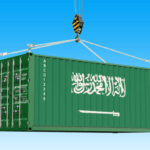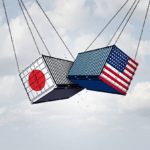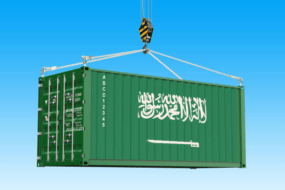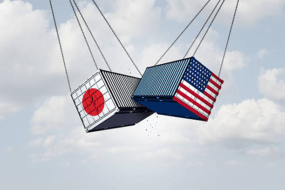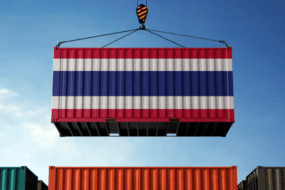- Home
- Trade News
- Trump Tariffs Take Toll on Glo ...

In a move that has rattled global stock markets and redrawn the contours of international trade, President Donald Trump has made good on his promise to prioritise “America First”—this time through a sweeping revival of tariffs that has sent shockwaves across continents.
From European Union leaders to emerging Asian economies, trading partners are reacting with a blend of apprehension, retaliatory tariffs, and cautious optimism, each seeking to preserve its stake in a rapidly shifting trade environment.
For some, tariffs are a punishing economic blow. For others, it presents a rare geopolitical opening. But for all, it signals a rebalancing of economic dynamics that could reset global trade for years to come.
“Reciprocal Tariffs” Already in Effect at US Ports
Amid calls for a “reciprocal tariffs” framework, the United States has begun enforcing duties at key ports, targeting countries it deems not offering fair market access to American goods.
Citing long-standing trade imbalances and what the White House terms “asymmetric policies,” the administration is positioning these tariffs as a levelling mechanism rather than an act of economic aggression.
According to Commerce Secretary Howard Lutnick, the new tariffs are necessary to protect American jobs and industries. However, the correction has come at a cost that American consumers, exporters, and foreign governments are beginning to realise.
20% for EU Countries
Perhaps the most headline-grabbing figure so far is the 20% tariff slapped on EU countries, a decision that has prompted Brussels to threaten its round of retaliatory measures.
“We are prepared to defend European interests,” an EU trade spokesperson declared, with murmurs of potential action on US-based tech firms and luxury exports already circulating.
The move has unsettled sectors relying heavily on transatlantic trade, particularly automotive, pharmaceuticals, and consumer electronics, adding to fears that a global recession could loom if tensions escalate further.
10% for Several Other Countries
Other countries have not been spared. A uniform 10% tariff applies to a broader list of trading partners, including long-time US allies in Asia and Latin America.
This decision reflects President Trump’s more expansive view of trade inequity, where even friendly nations are subject to scrutiny under what he has termed “America’s fair trade rules”.
According to US Treasury Secretary Scott Bessent, these measures pressure partners into “mutually beneficial agreements”. However, critics argue that the move risks alienating allies and damaging the very market value of US diplomatic leverage.
Impact of Trump Tariffs on India
India finds itself in an unusually nuanced position within this tariff web. As one of the few major economies not yet subject to the full brunt of Trump’s comments and policies, it’s using this moment to reposition itself on the global manufacturing map.
New Manufacturing Site for Apple, Samsung
In a twist of global irony, the very Trump tariffs intended to punish China and Vietnam may benefit India. Tech giants like Apple and Samsung, wary of escalating trade barriers on Chinese and Vietnamese production lines, are pivoting their manufacturing operations to Indian soil.
According to Indian Trade Ministry data, both companies have ramped up investments in industrial corridors across Tamil Nadu and Uttar Pradesh. This shift aligns with New Delhi’s ambitions to become a global electronics hub and may signal the start of a new era in South Asian trade dynamics.
Striking a Deal With the US
Interestingly, while many countries have moved to impose retaliatory tariffs, India has chosen a more strategic path. Government officials confirmed that India has no plans to retaliate against President Trump’s trade actions.
Instead, it is actively working to negotiate a new trade agreement with Washington to resolve long-standing issues on US imports such as dairy, pulses, and high-end motorbikes.
An Indian commerce ministry official, speaking anonymously, noted that the two sides aim to finalise a deal by autumn 2025.
Retaliation and Non-Retaliation vs Trump Tariffs
As the global chessboard shifts in response to the sweeping Trump tariffs, countries are faced with a pivotal choice: to retaliate or not. For some, the economic shock has triggered swift countermeasures. For others, the response is far more restrained—calculated, even.
China Is Retaliating
The intensifying trade dispute is a concern for China, which has wasted no time striking back. In direct response to President Trump’s sweeping tariff hike, raising import duties on Chinese goods to 104%, Beijing announced its retaliatory measures, levying up to 84% on a broad range of US exports.
The Trump tariffs disproportionately affect supply chains deeply embedded in Chinese manufacturing. Many of these companies have extended their operations into regional hubs such as Vietnam, Laos, Cambodia, Indonesia, Bangladesh, and Sri Lanka.
Indonesia and Taiwan Are Not Retaliating
In contrast, Indonesia and Taiwan have adopted noticeably restrained postures. This is particularly striking in the case of Taiwan, where the Taiex index, the country’s primary stock market, suffered one of the most severe hits globally following the Trump tariff announcement.
Yet, despite this market upheaval, Taipei has held back from imposing any direct countermeasures. Analysts suggest the decision reflects Taiwan’s desire to maintain economic stability and protect its crucial trade ties with the United States, especially in semiconductors and advanced electronics.
Indonesia, too, has opted for diplomacy over retaliation. With its growing aspirations to attract foreign investment and position itself as a neutral manufacturing alternative to China, Jakarta sees more benefit in maintaining open dialogue than escalating tensions.
Post-Trump Tariffs Global Market Turmoil
If there was any lingering doubt about the impact of the Trump tariffs, the massive sell-off across global stock markets swiftly dispelled it.
What began as President Donald Trump’s calculated policy shift has snowballed into a period of heightened volatility, particularly in Asian financial markets, many of which are closely linked to export-heavy economies and global trade flows.
- Taiex (Taiwan): Perhaps the most immediate casualty, the Taiwan Stock Exchange triggered a circuit breaker after plunging over 10% within hours of the tariff announcement. Rattled by Taiwan’s strategic exposure to US-China tech tensions, investors dumped equities in droves.
- Nikkei (Japan): Japan’s Nikkei 225 shed nearly 5% in a single trading session. The pullback reflected fears that Japan’s automakers and electronic giants—many of which have production hubs in China and Vietnam—could be caught in the crossfire of the new reciprocal tariffs.
- Kospi (South Korea): South Korea’s index tumbled amid renewed uncertainty over chip exports and manufacturing. With Samsung and SK Hynix deeply integrated into global supply chains, investors responded to Trump’s comments with stark caution.
- CSI300 (China): In mainland China, the CSI300 index dropped more than 4%, despite Beijing’s best efforts to contain panic. As the origin point of many global manufacturing networks, China bears direct and indirect tariff pain, which is now compounded by retaliatory measures.
- Hang Seng (Hong Kong): Already beleaguered by years of political unrest and capital flight, the Hang Seng took another hammering. Hong Kong’s heavy reliance on trade finance and logistics made it especially vulnerable to deteriorating global trade conditions.
- Bursa Malaysia: The Malaysian bourse saw broad-based losses, especially in palm oil and electronics, underscoring its exposure to China-centric supply chains.
- PSE (Philippines): The Philippine Stock Exchange closed down 3.8% amid capital outflows and recession fears, further exacerbated by its dependence on foreign trade and remittances.
- Sensex and Nifty 50 (India): While Indian equities were relatively insulated, both the Sensex and Nifty 50 saw corrections driven by global sentiment.
This synchronised downturn reflects more than just a knee-jerk investor reaction. It points to a deeper unease in the global economy, where long-standing assumptions about free trade, open markets, and predictable supply chains are rapidly upended.
Macroview of Trump Tariff Effects on Import/Export
The resurgence of Trump tariffs has triggered immediate disruptions in trade routes and stock markets and deeper shifts in the global economic architecture. While some countries scramble to adjust supply chains, others face eroding market value and sector-specific shocks.
India
Despite initial optimism surrounding increased manufacturing activity, a closer inspection of the Indian export economy reveals a more sobering picture.
While Apple and Samsung setting up new manufacturing hubs may offer medium-term advantages, Indian economists are raising red flags about more immediate pain points, particularly in sectors like diamonds, where over one-third of total exports are bound for the US market.
The Trump tariffs have long shadowed India’s polished diamond industry, threatening thousands of jobs and export revenue.
Unlike mobile phone assembly, where supply chains can be quickly reconfigured, diamond exports rely on entrenched US demand and time-tested distribution channels that are not easily redirected.
Global
At a macro level, the ramifications of the Trump tariffs are resounding far beyond bilateral trade figures. According to the President of the Asia Society, Donald Trump’s trade policies are not just disrupting supply chains, they are threatening to collapse certain national economies outright.
The return to aggressive, zero-sum trade thinking, spearheaded by President Donald Trump and reinforced by his advisers, such as Commerce Secretary Howard Lutnick and Treasury Secretary Scott Bessent, has effectively reset global trade norms, bringing the world economy toward an uncertain new normal.
Long-standing trading partners and adversaries are unsure whether to impose retaliatory tariffs, negotiate, or simply hang tough and hope for better days.
Conclusion: A Global Trade Map Redrawn
The world’s trade dynamics are being redrawn at pace, not on anyone’s familiar terms. With over 50 countries now seeking tariff talks with the United States, the Trump tariffs have made one thing clear: the era of predictable global commerce is over. The trade landscape has shifted dramatically, and staying ahead now demands more than policy alignment.
At TradeDataPro, we believe access to timely, accurate trade intelligence has never been more essential. As the global trade map is evolving in real-time, our platform empowers you to stay ahead, from analysing US imports and identifying shifts in stock markets to preparing to meet Trump-era challenges head-on.


